Students can Download 2nd PUC Biology Previous Year Question Paper March 2020, Karnataka 2nd PUC Biology Model Question Papers with Answers helps you to revise the complete Karnataka State Board Syllabus and score more marks in your examinations.
Karnataka 2nd PUC Biology Previous Year Question Paper March 2020
Time: 3 hrs 15 min
Max. Marks: 70
General Instructions
- This question paper consists of four parts A, B, C and D. Part – D consists of two sections. Section – I and Section – II.
- All the parts are compulsory.
- Draw diagrams wherever necessary. Unlabelled diagrams or illustrations do not attract any marks.
Part – A
Answer the following questions in one word or one sentence each. (10 × 1 = 10)
Question 1.
How many chromosomes are there in meiocytes of human beings?
Answer:
46.
Question 2.
Name the inducer which regulates the switching on and off of the lac operon.
Answer:
Lactose.
Question 3.
Which type of R.N.A. polymerase enzyme transcribes precursor m.R.N.A.?
Answer:
RNA polymerase II.
![]()
Question 4.
Name the part of the flower which develops into the fruit after fertilization.
Answer:
Ovary.
Question 5.
Write the scientific name of the fungus which produce cyclosporin A.
Answer:
Trichoderma polysporum.
Question 6.
What are Pioneer species?
Answer:
The species that invade a bare area is Pioneer species.
Question 7.
Which bacteria is commonly found in the anaerobic sludge during sewage treatment?
Answer:
Methanogens/Methanobacterium.
Question 8.
Name the International treaty which controls the emission of ozone-depleting substances.
Answer:
Montreal protocol.
![]()
Question 9.
Define endemism.
Answer:
A species native to a particular region and found nowhere else in the world is called as endemic species.
Question 10.
What are Euryhaline organisms?
Answer:
Euryhaline organisms which tolerate a wide range of salinities.
Part – B
Answer any five of the following questions in 3 to 5 sentences each: Wherever applicable: (5 × 2 = 10)
Question 11.
Name the scientist who found out D.N.A. and what was the name given by him?
Answer:
Friedrich Mischer. The name given is ‘Nuclein’.
Question 12.
Write the accessory ducts found in the male reproductive system.
Answer:
Rete testis, Vasefferentia,Vas deferens, Epididymis.
![]()
Question 13.
Mention the genotype of the parents when their children are with A, B, AB, O blood groups.
Answer:
IAi, IBi.
Question 14.
Name the two hormone-releasing I.U.Ds.
Answer:
Progestasert and LNG-20.
Question 15.
What are the two types of disorders of humans where the Karyotype is 47?
Answer:
Down’s syndrome and Klinefelter’s syndrome.
Question 16.
Name the two primates those were existing in 15 mya.
Answer:
Diyopithecus and Ramapithecus.
Question 17.
Mention the two diseases resisted by mungbean through mutation breeding.
Answer:
yellow mosaic virus and Powdery mildew.
![]()
Question 18.
Write the two basic amino acid residues which are rich in histones.
Answer:
Lysine and Arginine.
Part – C
Answer any five of the following questions in about 40 to 80 words each wherever applicable: (5 × 3 = 15)
Question 19.
Mention the asexual reproductive structure of the following
- Penicillium
- Hydra
- Sponges
Answer:
Budding, Bulbils, Neelakuranji (Strobilanthus kunthiana)
- Conidia
- Zoospores
- Gemmule formation
Question 20.
Sketch and label Miller’s Experiment.
Answer:
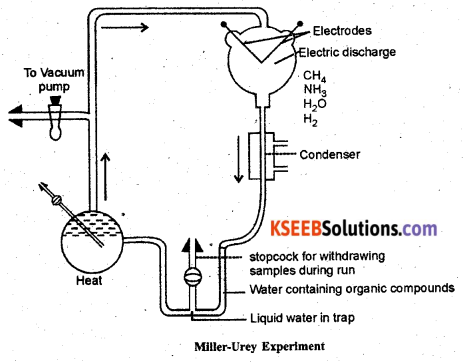
Question 21.
Name the diseases caused by the following organism:
- Rhinovirus
- Wuchereria bancrofti
- Haemophilus influenza.
Answer:
- Common cold
- Filariasis/Elephantiasis
- Pneumonia
![]()
Question 22.
Define Infertility. Write two assisted reproductive technology to overcome infertility.
Answer:
Inability to produce children. ZIFT, GIFT.
Question 23.
Schematically represent the phosphorous cycle.
Answer:
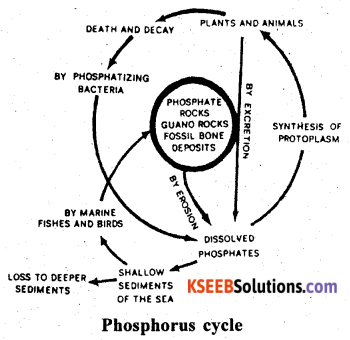
Question 24.
What is ecological succession? How Hydarch succession is different from that of xerarch succession?
Answer:
- The gradual and fairly predictable change in the species composition of a given area is called ecological succession.
- Hydrarch succession takes place in wetter areas and the successional series progress from hydric to the mesic conditions.
- It involves the pioneer stage, submerged stage, floating stage, reed swamp stage, marsh meadow stage, woodland stage and forest stage.
- Xerarch succession takes place in dry areas and the series progress from xeric to mesic conditions.
- The stages include crustose lichen stage, foliose lichen stage, moss stage, herb stage, shrub stage and tree stage.
Question 25.
Alien species invasion caused the decline or extinction of indigenous species. Justify the statement by giving three examples.
Answer:
- Introduction of Nile Perch into Lake Victoria in East Africa led eventually to the extintion of more than 200 species of orchid fishes in the lake.
- Introduction of African catfish clarias gariepinus for aquaculture purposes is posing a threat to the indigenous catfishes in our rivers.
![]()
Question 26.
Define Autogamy. Write the two different kinds of flowers that exhibit autogamy.
Answer:
When the pollen grains pollinate the stigma of the same flower it is called autogamy.
E.g.: Commelina, Oxalis.
Part – D
Section – I
Answer any four of the following questions in about 200 to 250 words each, wherever applicable: (4 × 5 = 20)
Question 27.
Explain a mature embryo sac with a neat labelled diagram.
Answer:
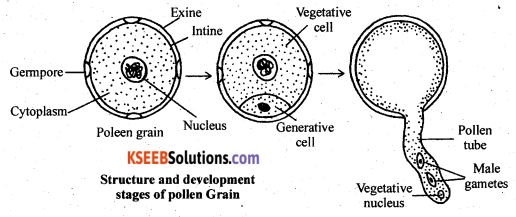
Embryosac: It is the female gametophyte present in the nucleus towards the micropylar end. It çonsists of three antipodal cells towards the chalazal end, secondary nucleus at the centre and egg apparatus towards the micrograph lar end. Egg apparatus consists of a central egg cell and two lateral synergid cells.
Question 28.
Schematically represent the inheritance of two genes in pea plants with reference to seed colour and shape.
Answer:
It is a cross between two plants differing in 2 pairs of contrasting characters. Mendel selected shape of the seed and colour of the cotyledons as the two pairs of contrasting characters. The round seed coat is dominant over wrinkled seed coat and yellow colour of cotyledon is dominant over the green colour. Mendel crossed a pure breeding garden pea plant producing round and yellow seeds with a pure breeding garden pea plant producing wrinkled and green seeds.
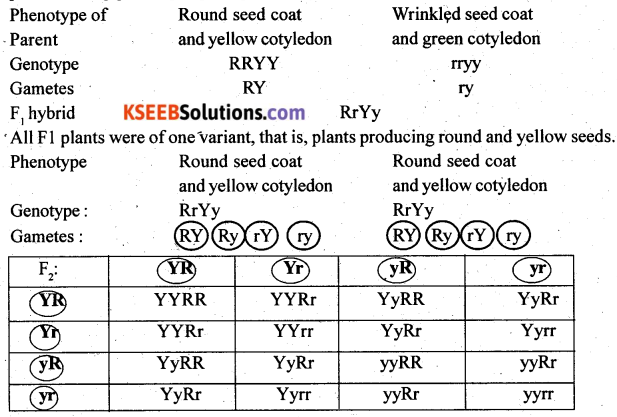
Round seed coat and yellow cotyledons = 9
Wrinkled seed coat and yellow cotyledons = 3
Round seed coat and green cotyledons = 3
Wrinkled seed coat and green cotyledons = 1
Dihybrid phenotypic ratio = 9 : 3 : 3 : 1.
Genotypicratio = 1 : 2 : 2 : 4 : 1 : 2 : 1 : 2 : 1.
Thus in the F2 generation, he got Yellow Round, Yellow wrinkled, Green round and Green wrinkled in the ration of 9 : 3 : 3 : 1, respectively.
![]()
Question 29.
Mention five salient features of the human genome project.
Answer:
HGP got success in the following aspects.
- This project identified nearly 30,000 to 35,000 genes of human DNA.
- They identified 3164.7 million nitrogen bases ¡n the human genome
- They identified the size and number of bases in genes. The average gene has 3000 bases and the largest human gene. dystrophin has 2.4 million bases.
- They identified the fact that all human beings are 99.9% identical with each other and only 0.1 % are different.
- They identified that the chromosome-1 has a maximum number of genes le 2968 genes and y chromosome has the lowest number of genes i.e. 231.
- They identified that only 2% of the genome codes for protein and the remaining 98% of DNA remains functionless. This non-functional DNA is called Junk DNA.
Question 30.
(a) Define immunity and name two different types of immunity.
Answer:
Immunity could be defined as resistance to diseases. It can be natural or artificial.
- Active immunity.
- Passive immunity.
(b) Draw a neat labelled diagram of the structure of an antibody molecule.
Answer:
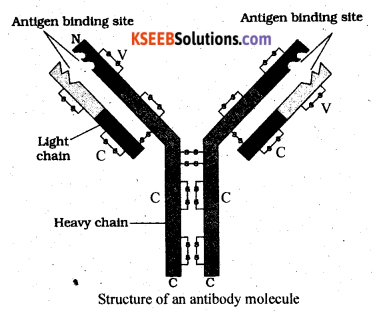
Question 31.
With reference to tissue culture explains the following terms:
- Explant
- Totipotency
- Some clones
- Somatic hybrids
- Micropropagation
Answer:
- Any part of a plant taken out and grown in a test tube under sterile conditions in special nutrient media is called explant.
- The capacity to generate a whole plant from any celllex plant is called totipotency.
- Plants which are genetically identical to the original plant from which they are grown are called some clones.
- Isolated protoplasts from two different varieties of plants each having a desirable character can be fused to get hybrid protoplasts, which can be further grown to form a new plant. These hybrids are called somatic hybrids.
- Producing thousands of plants through tissue culture is called micropropagation.
![]()
Question 32.
Explain briefly how transgenic animals benefit human beings.
Answer:
Transgenic animals:
An animal developed by introducing the desired foreign gene is called a Transgenic animal.
Transgenic animals can be produced by the following methods.
- Microinjection of desired genes into the pronucleus of the fertilized egg.
- Retroviral infection of fertilised eggs at 4 to 8 celled stages.
- Genetic alterations of embryonic stem cells [ESC] and their reintroduction into the blastocyst.
Transgenic animals are useful in biological, biomedical and biotechnological researches especially in animal husbandry, dairy and pharmaceutical industries.
Note: Transgenic animals are used as bioreactors for mass production of drugs and proteins. It is
called gene farming or molecular farming.
e.g.:
| Organism | Genes incorporated | Uses |
| (a) Sheep and swine | Human growth hormone | Improvements in body weight gain, feed efficiency, lean/fat ratio, fat composition etc. |
| (b) Sheep | Bacterial genes cys E and cys M | Improved wool production and quality. |
| (c) Rabbit | Interleukin 2 tissue plasminogen activator α1 – antitrypsin α – lactoglobulin |
Genes expressed in mammary tissue proteins are harvested from milk. |
Benefits of transgenic animals:
1. Normal physiology and development: Transgenic animals can be specifically designed to allow the study of how genes are regulated, and how they affect the normal functions of the body and its development.
2. Study of disease: Many transgenic animals are designed to increase our understanding of how genes contribute to the development of the disease. e.g. Cancer, cystic fibrosis, rheumatoid arthritis and Alzheimer’s.
3. Biological products: Medicines required to treat certain human diseases are biological products. But such useful biological products can be created by the introduction of the portion of DNA (or genes) into an animal which codes for a particular transgenic product.
4. Vaccine safety: Safety of vaccines must be confirmed before they ae administered. e.g. Transgenic mice are being used to test the safety of the polio vaccine.
5. Chemical safety testing: This is known as toxicity/safety testing. The procedure is the same as that used for testing the toxicity of drugs. Transgenic animals are made to carry genes which make them more sensitive to toxic substances than non-transgenic animals. They are then exposed to the toxic substances and the effects studied.
Section – II
Answer any three of the following questions in about 200 to 250 words each, wherever applicable: (3 × 5 = 15)
Question 33.
Draw a neat labelled diagram of a sectional view of the female reproductive system.
Answer:

Question 34.
Explain the biogas plant with a neat labelled diagram.
Answer:
Biogas is a mixture of gases (containing predominantly methane) produced by the microbial activity and which may be used as fuel. Microbes produce different types of gaseous end-products during growth and metabolism. The type of gas produced depends upon the microbes and the organic substrates they utilise. Bacteria, which grow anaerobically on cellulosic material, produce a large amount of methane along with CO2 and H2. These bacteria are collectively called methanogens, and one such common bacterium is methanobacteriurn. These bacteria are commonly found in the anaerobic sludge during sewage treatment. These bacteria are also present in the rumen (a part of the stomach) of cattle. A lot of cellulosic material present in the food of cattle is also present in the
rumen.
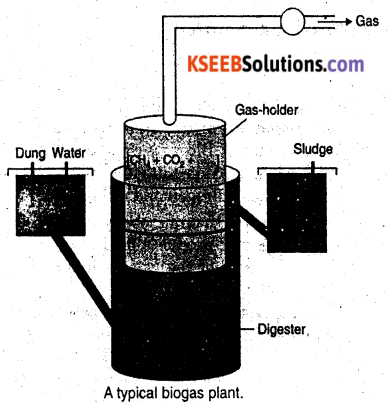
Note: In the rumen, these bacteria help in the breakdown of cellulose and play an important role in the nutrition of cattle.
The excreta (dung) of cattle, commonly called gobar, is rich in these bacteria. Dung can be used for the generation of biogas, commonly called gobar gas.
The biogas plant consists of a concrete tank (10-15 feet deep) in which bio-wastes are collected and a slurry of dung is fed. A floating cover is placed over the slurry, which keeps on rising as the gas is produced in the tank due to the microbial activity. The biogas plant has an outlet, which is connected to a pipe to supply biogas to nearby houses. The spent slurry is removed through another outlet and may be used as a fertiliser. Cattle dung is available in large quantities in rural areas where cattle are used for a variety of purposes. So, biogas plants are more often built in Ñral areas. The biogas thus produced ¡s used for cooking and lighting.
![]()
Question 35.
Mention the population interactions exist among the following:
- Abingdon tortoise and goats in Galapagos islands. (1)
- The cuckoo lays eggs in crow’s nest. (1)
- Sea-anemone and clownfish. (1)
- Wasp laying eggs in fig fruit. (1)
- Orchid Ophrys and bees. (1)
Answer:
- Competition
- Brood Parasitism
- Commensalism
- Co-evolution
- Sexual deceit
Question 36.
(a) Differentiate Endonucleases and Exonucleases. (2)
Answer:
Restriction enzymes are the nucleases. They are of two types namely exonucleases and endonucleases.
Exonucleases remove nucleotides from the ends of the DNA and endonucleases can cut at specific points within the DNA itself.
(b) Diagrammatically represents recombinant D.N.A. technology. (3)
Answer:

Question 37.
Write a note on the following:
(a) Remedy for plastic waste. (2)
Answer:
- Poly blend, a fine powder of recycled modified plastic, was developed in the factory.
- Polyblend is mixed with bitumen that is used to lay roads.
- It increases the water-repelling property of bitumen and helped to increase road life by a factor of three.
- The raw material used for polyblend is plastic film waste.
- It is economical also.
![]()
(b) Radioactive wastes. (3)
Answer:
Radiation, which is given off by nuclear waste is extremely damaging to organisms because it causes mutations at a very high rate. At high doses nuclear radiation is lethal but at lower doses, it creates various disorders, the most frequent of all being cancer. Therefore, nuclear waste is än extremely potent pollutant and has to be dealt with utmost caution. It has been recommended that storage of nuclear waste, after sufficient pre-treatment, should
be done in suitable shielded containers, buried within the rocks, about 500 m deep below the earth’s surface.